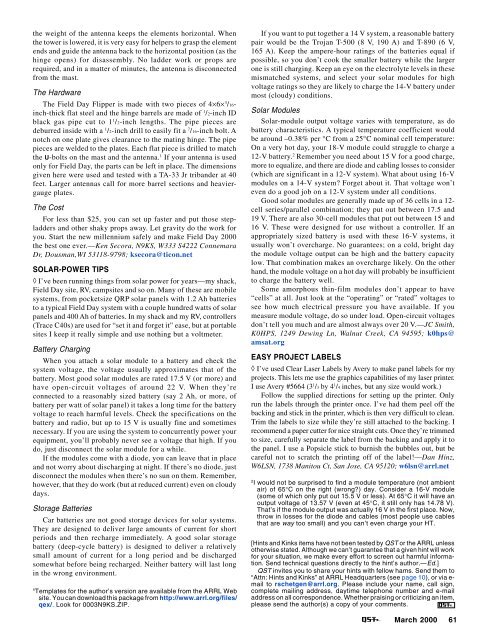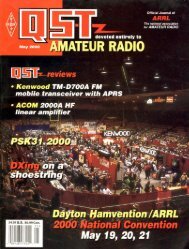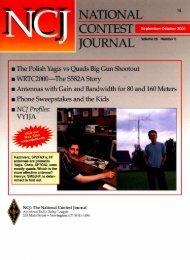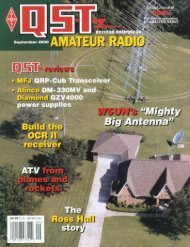March 2000 QST
March 2000 QST
March 2000 QST
- No tags were found...
Create successful ePaper yourself
Turn your PDF publications into a flip-book with our unique Google optimized e-Paper software.
the weight of the antenna keeps the elements horizontal. Whenthe tower is lowered, it is very easy for helpers to grasp the elementends and guide the antenna back to the horizontal position (as thehinge opens) for disassembly. No ladder work or props arerequired, and in a matter of minutes, the antenna is disconnectedfrom the mast.The HardwareThe Field Day Flipper is made with two pieces of 4×6× 3 /16-inch-thick flat steel and the hinge barrels are made of 1 /2-inch IDblack gas pipe cut to 1 1 /2-inch lengths. The pipe pieces aredeburred inside with a 1 /2-inch drill to easily fit a 7 /16-inch bolt. Anotch on one plate gives clearance to the mating hinge. The pipepieces are welded to the plates. Each flat piece is drilled to matchthe U-bolts on the mast and the antenna. 1 If your antenna is usedonly for Field Day, the parts can be left in place. The dimensionsgiven here were used and tested with a TA-33 Jr tribander at 40feet. Larger antennas call for more barrel sections and heaviergaugeplates.The CostFor less than $25, you can set up faster and put those stepladdersand other shaky props away. Let gravity do the work foryou. Start the new millennium safely and make Field Day <strong>2000</strong>the best one ever.—Ken Secora, N9KS, W333 S4222 ConnemaraDr, Dousman,WI 53118-9798; ksecora@ticon.netSOLAR-POWER TIPS◊ I’ve been running things from solar power for years—my shack,Field Day site, RV, campsites and so on. Many of these are mobilesystems, from pocketsize QRP solar panels with 1.2 Ah batteriesto a typical Field Day system with a couple hundred watts of solarpanels and 400 Ah of batteries. In my shack and my RV, controllers(Trace C40s) are used for “set it and forget it” ease, but at portablesites I keep it really simple and use nothing but a voltmeter.Battery ChargingWhen you attach a solar module to a battery and check thesystem voltage, the voltage usually approximates that of thebattery. Most good solar modules are rated 17.5 V (or more) andhave open-circuit voltages of around 22 V. When they’reconnected to a reasonably sized battery (say 2 Ah, or more, ofbattery per watt of solar panel) it takes a long time for the batteryvoltage to reach harmful levels. Check the specifications on thebattery and radio, but up to 15 V is usually fine and sometimesnecessary. If you are using the system to concurrently power yourequipment, you’ll probably never see a voltage that high. If youdo, just disconnect the solar module for a while.If the modules come with a diode, you can leave that in placeand not worry about discharging at night. If there’s no diode, justdisconnect the modules when there’s no sun on them. Remember,however, that they do work (but at reduced current) even on cloudydays.Storage BatteriesCar batteries are not good storage devices for solar systems.They are designed to deliver large amounts of current for shortperiods and then recharge immediately. A good solar storagebattery (deep-cycle battery) is designed to deliver a relativelysmall amount of current for a long period and be dischargedsomewhat before being recharged. Neither battery will last longin the wrong environment.1Templates for the author’s version are available from the ARRL Website. You can download this package from http://www.arrl.org/files/qex/. Look for 0003N9KS.ZIP.If you want to put together a 14 V system, a reasonable batterypair would be the Trojan T-500 (8 V, 190 A) and T-890 (6 V,165 A). Keep the ampere-hour ratings of the batteries equal ifpossible, so you don’t cook the smaller battery while the largerone is still charging. Keep an eye on the electrolyte levels in thesemismatched systems, and select your solar modules for highvoltage ratings so they are likely to charge the 14-V battery undermost (cloudy) conditions.Solar ModulesSolar-module output voltage varies with temperature, as dobattery characteristics. A typical temperature coefficient wouldbe around –0.38% per °C from a 25°C nominal cell temperature:On a very hot day, your 18-V module could struggle to charge a12-V battery. 2 Remember you need about 15 V for a good charge,more to equalize, and there are diode and cabling losses to consider(which are significant in a 12-V system). What about using 16-Vmodules on a 14-V system? Forget about it. That voltage won’teven do a good job on a 12-V system under all conditions.Good solar modules are generally made up of 36 cells in a 12-cell series/parallel combination; they put out between 17.5 and19 V. There are also 30-cell modules that put out between 15 and16 V. These were designed for use without a controller. If anappropriately sized battery is used with these 16-V systems, itusually won’t overcharge. No guarantees; on a cold, bright daythe module voltage output can be high and the battery capacitylow. That combination makes an overcharge likely. On the otherhand, the module voltage on a hot day will probably be insufficientto charge the battery well.Some amorphous thin-film modules don’t appear to have“cells” at all. Just look at the “operating” or “rated” voltages tosee how much electrical pressure you have available. If youmeasure module voltage, do so under load. Open-circuit voltagesdon’t tell you much and are almost always over 20 V.—JC Smith,K0HPS, 1249 Dewing Ln, Walnut Creek, CA 94595; k0hps@amsat.orgEASY PROJECT LABELS◊ I’ve used Clear Laser Labels by Avery to make panel labels for myprojects. This lets me use the graphics capabilities of my laser printer.I use Avery #5664 (3 1 /3 by 4 1 /4 inches, but any size would work.)Follow the supplied directions for setting up the printer. Onlyrun the labels through the printer once. I’ve had them peel off thebacking and stick in the printer, which is then very difficult to clean.Trim the labels to size while they’re still attached to the backing. Irecommend a paper cutter for nice straight cuts. Once they’re trimmedto size, carefully separate the label from the backing and apply it tothe panel. I use a Popsicle stick to burnish the bubbles out, but becareful not to scratch the printing off of the label!—Dan Hinz,W6LSN, 1738 Manitou Ct, San Jose, CA 95120; w6lsn@arrl.net2I would not be surprised to find a module temperature (not ambientair) of 65°C on the right (wrong?) day. Consider a 16-V module(some of which only put out 15.5 V or less). At 65°C it will have anoutput voltage of 13.57 V (even at 45°C, it still only has 14.78 V).That’s if the module output was actually 16 V in the first place. Now,throw in losses for the diode and cables (most people use cablesthat are way too small) and you can’t even charge your HT.[Hints and Kinks items have not been tested by <strong>QST</strong> or the ARRL unlessotherwise stated. Although we can’t guarantee that a given hint will workfor your situation, we make every effort to screen out harmful information.Send technical questions directly to the hint’s author.—Ed.]<strong>QST</strong> invites you to share your hints with fellow hams. Send them to“Attn: Hints and Kinks” at ARRL Headquarters (see page 10), or via e-mail to rschetgen@arrl.org. Please include your name, call sign,complete mailing address, daytime telephone number and e-mailaddress on all correspondence. Whether praising or criticizing an item,please send the author(s) a copy of your comments.<strong>March</strong> <strong>2000</strong> 61
















